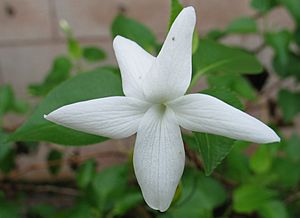Viola chamissoniana facts for kids
Quick facts for kids Viola chamissoniana |
|
|---|---|
 |
|
| Conservation status | |
| Scientific classification | |
| Genus: |
Viola (plant)
|
| Species: |
chamissoniana
|
The ʻolopu (scientific name: Viola chamissoniana) is a beautiful flowering plant that belongs to the violet family. This special plant is found only in Hawaii, which means it is endemic to those islands. You can find it growing on Kauai, Oahu, Molokai, and Maui.
Contents
What is the ʻOlopu Plant?
The ʻolopu plant is a type of woody shrub. This means it has a stem that is a bit like a small tree trunk. It grows from a main root called a taproot. Sometimes, if the lower part of its stem touches the ground, new roots can grow from there!
How Does it Grow?
The leaves of the ʻolopu plant can be quite large, growing up to 29 centimeters long and 9 centimeters wide. Their edges are a bit bumpy, like tiny teeth.
The flowers are a pretty white color, sometimes with a hint of purple. Each petal is about 1 to 2 centimeters long. After the flowers bloom, they turn into a fruit that looks like a small capsule. This capsule is also 1 to 2 centimeters long and holds many tiny, dark seeds inside.
Why is the ʻOlopu Plant Special?
There are three different types, or subspecies, of the ʻolopu plant. One subspecies, called tracheliifolia, is quite common. However, another subspecies, chamissoniana, is very rare.
This rare subspecies is listed as an endangered species in the United States. This means it is in danger of disappearing forever! It only grows on the island of Oahu.
Protecting the ʻOlopu
Today, there are only about 443 of these special ʻolopu plants left in the wild. They grow in three main groups in the Waiʻanae Range mountains. Many of these plants live on steep cliffs, which helps keep them safe from some dangers.
To protect them even more, fences have been put up. These fences help stop feral goats from eating the plants. Another big problem for the ʻolopu is other plants that are not native to Hawaii. These "exotic plants," like the Maui pamakani, can grow very fast and take over the space and sunlight that the ʻolopu needs to survive. People are working hard to protect this unique Hawaiian plant!


